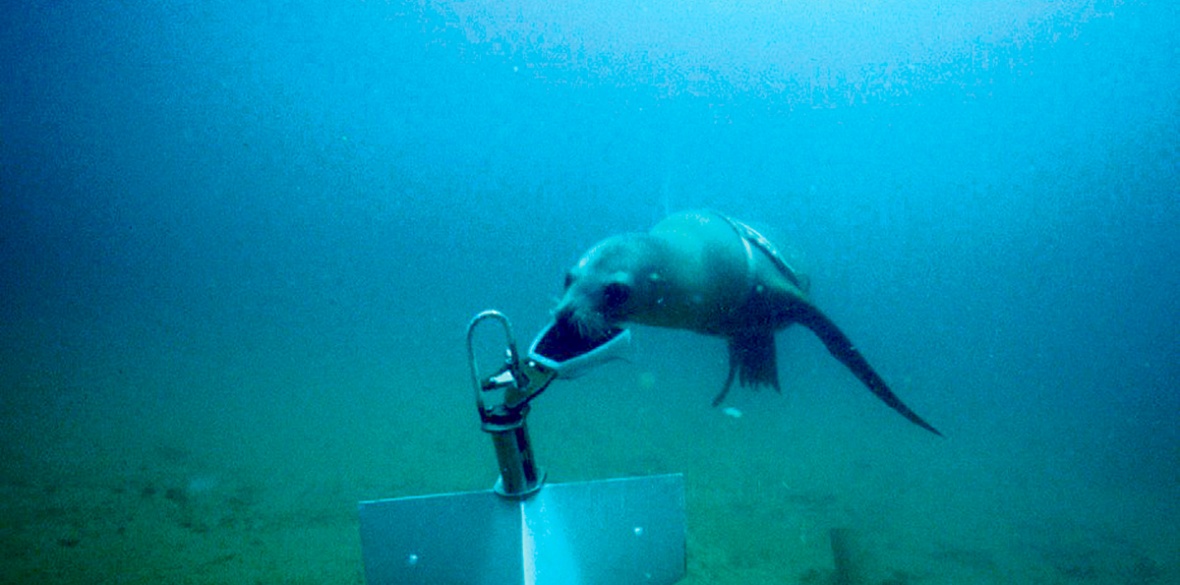This is the last article you can read this month
You can read more article this month
You can read more articles this month
Sorry your limit is up for this month
Reset on:
Please help support the Morning Star by subscribing here
The history of using whales in war is long and shocking. Like other evil weapons of war it was the Brits — that’s you and me I’m afraid — that invented it.
Like concentration camps, guided missiles and several hundred other dastardly ways to win a war.
We started in the first world war training zoo-bred sea lions. The navy took them to Lake Bala in Wales to try to train them to find German submarines. They were quick learners, these intelligent sea lions. So intelligent, in fact, that when they were released into the sea they located large schools of herring and mackerel which they ate all day.
German U-boats came and went unnoticed by these huge honking relatives of our native seals.
We also trained seals to place magnetic mines on enemy shipping as we had trained dogs to be live bombs on the battlefield. Seals or dogs, this proved just as unsuccessful as it was cruel.
I have no doubt at all that our military forces, led by Tory Defence Secretary Penny Mordaunt, Gavin Williamson, Michael Fallon, Phillip Hammond and Liam Fox (note to editor, please check as near to publication as possible to see that Penny Mordaunt still has the job) are still developing all kinds of secret weapons, perhaps utilising wild animals – but how would we ever know, it isn’t as if any senior minister would leak it.
During the Cold War the US Navy developed a marine mammal programme to train dolphins and sea lions for underwater sentry duty, mine clearance, and recovery of objects from the sea bed.
Since the 1960s US military scientists realised the ability of these animals to detect and find targets at depth or in murky water. This is something man-made technology can’t duplicate yet, but which the military finds very valuable.
The US Navy trains its marine mammals including Californian sea lions and bottlenose dolphins to find and retrieve equipment lost at sea and to identify intruders swimming into restricted areas.
The dolphins are also used to detect underwater mines, either buried in the seafloor or floating from an anchor.
Something marked Equipment of
St Petersburg is more likely to
be on a piece of diving kit made in Florida than Russia
The dolphins and whales use echolocation where finely tuned sonar sound signals are sent out to bounce off objects in the surrounding environment. The mammals pick up the return echoes and form an acoustic picture of their environment.
Californian sea lions don’t possess sonar capabilities but do have excellent eyesight. The US Navy uses them to find and retrieve mines. Handlers give a sea lion an attachment system it can hold in its mouth. Once the animal finds its target, it clamps the device to the mine and handlers in a boat at the surface can bring the mine in.
In 2011 the US Navy showed the media how dolphins and sea lions could catch a human diver attempting to infiltrate the harbour with a mine. The Navy-trained dolphins and sea lions caught the diver on every one of his five attempts. The sea lion even managed to attach a clamp to the diver’s leg and handlers on the surface reeled him in like a fish.
These many US developments were supposed to be hush-hush too, but this was the beginning of the “Save the Whale” generation and whale secrets were hard to keep.
Today whales as weapons are back in the headlines with the story of a white beluga whale that approached a fishing boat near a small Norwegian town this spring.
This beluga raised suspicions when it approached boats apparently begging for food. It pulled on ropes and showed no fear of human beings – indeed it seemed almost tame.
The Norwegian fisher folk noticed it was wearing a harness that looked like it was fitted to carry a camera. Most peculiar was that the harness bore a maker’s name. It was emblazoned with brand name “Equipment of St Petersburg.”
Immediately espionage experts suggested that the whale was part of a Russian military programme that trains all kinds of marine mammals in military operations. None of these experts spotted that the label was in English and in Roman not Cyrillic script — could this be a cunning double bluff by Russian intelligence?
St Petersburg is also a seaside city in Florida where the main industry is scuba and sports diving and making and selling all the diving equipment — including harnesses. Something marked Equipment of St. Petersburg is more likely to be on a piece of diving kit made in Florida rather than Russia.
However, we do know the Russians both in Soviet times and later experimented with this kind of warfare including using marine mammals.
In 2017, Russian state television reported that Russia had been and was experimenting with beluga whales, bottlenose dolphins, and several species of seals to guard entrances to naval bases, assist divers and perhaps even attack trespassers in Russian territorial waters.
There have also been reports from the Russian news agency Novosti of Ukrainian military units made up of bottlenose dolphins. These so-called Sevastopol combat dolphins are trained to search for and tag underwater mines or unwanted divers or swimmers attempting to access restricted waterways.
A 2017 report by TV Zvezda — a station owned by the Defence Ministry — revealed that the Russian navy has again been training beluga whales, seals and bottlenose dolphins for military purposes in polar waters.
Perhaps this has something to do with the fact that in the past three years, President Vladimir Putin has reopened three former Soviet military bases along its vast Arctic coastline.
The TV programme revealed that recent research and training was done by Murmansk Sea Biology Research Institute in northern Russia.
Government public records show that the Defence Ministry purchased five bottle-nosed dolphins from Moscow’s Utrish Dolphinarium in 2016 for £18,000.
It’s a complicated story and finding the truth in a mass of lies, secrets and false information I can’t help linking it with another story I reported in these pages a few months ago.
Do you remember a white beluga turning up thousands of miles from its Arctic home in the mouth of the Thames? Was it on a spying mission from the US or Russia? Or did it swim downriver from the MI5 headquarters just upstream?
There is a large ramp from the MI5 Headquarters building into the river and I always wondered what it was for.










